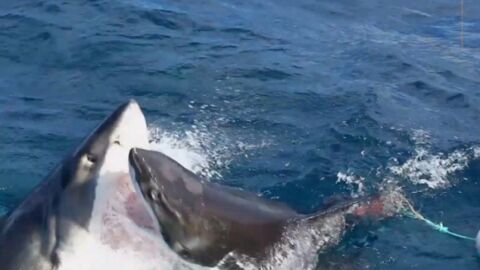Our story begins 14 years ago, when a researcher from Stanford university, Barbara Block, attached GPS tracking devices to the necks of multiple great white sharks in order to study their movements, and another one of their habits was then revealed. Although they hunt elephant seals and other marine mammals between August to December, they move away from the fishy Californian coasts once winter hits.
Discover our latest podcast
But where do they go? The trackers have revealed that an enormous number of great white sharks migrate to an area located halfway between the western coast of the United States and Hawaii. From satellite images, the area could be described as a vast desert with seemingly no particular attraction for one of most renowned carnivores in the animal kingdom. Do they migrate with the purpose of finding food and reproducing? This mystery is still unclear.
A month-long expedition to find out more
Barbara Block therefore set up a month-long expedition in spring to discover why these beasts migrate here. Thanks to the tracking devices, Barbara and her team followed the 36 tracked great whites on their journey towards the ‘White Shark Café’. And they found more than they expected they would.
During their 1,500-kilometre-long journey, the sharks descended more than 900 metres deep, which was easy to do using the currents of the water. This was the first surprise, since we originally thought their metabolism was incapable of withstanding such pressures and temperatures that are found in these depths. Once they reached their destination, the sharks still dove deeper, but to different depths depending on the time of day.
The sharks went up to 450 metres deep during the night and 200 metres during the day. However, researchers observed some differences in the males and females from April. Although the males were increasing their activity, passing more than 140 dives per day, the females maintained a constant activity.
Multiple fish in the depths
Scientists were surprised to observe that the sharks then found themselves in a real restaurant off the coasts of California. Many creatures from the depths live there, lurking in the darkness somewhere between the surface and the great abyss in a part of the ocean that we still know little about.
‘The story of the white shark tells you that the area is vitally important in ways we never knew about,’ says Salvador Jorgensen, one of the scientists on the expedition, to the San Francisco Chronicle. ‘They are telling us this incredible story about the mid-water, and there is this whole secret life that we need to know about.’
However, what is for sure is that the great white’s diving is correlated with the habits of other species that live there. There are jellyfish, squid and fish that dive or resurface depending on the time of day since they thrive in darker conditions. All these creatures together in one place provide a true buffet for the great whites.
‘The largest migration of animals on Earth’
‘It’s the largest migration of animals on Earth – a vertical migration that’s timed with the light cycle,’ continues Jorgensen.
‘During the day they go just below where there is light and at night they come up nearer the surface to warmer, more productive waters under the cover of darkness.’
Great whites aren’t the only predators that hunt these creatures that live in mid-waters. The bigeye tuna (a species that can measure up to 2m long), blue sharks and mako also live in this area. And it’s likely that they all end up on the great white sharks’ menu.
‘What we’ve learned through the progression of our research is that this mid-water layer is extremely important for white sharks. They are swimming in these layers, tracking (prey) day and night… It’s a game of hide and seek,’ explains Jorgensen.
And three weeks into the expedition, the team collected more data than was collected in the last twenty years of studying great whites. We should therefore expect more new discoveries in the upcoming weeks. Scientists are especially hoping to be able to understand the behavioral differences between male and females. Are there differences in their diet or with reproduction? This mystery remains unresolved for now.















